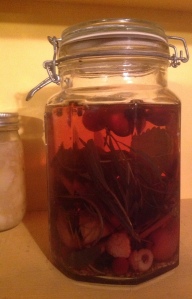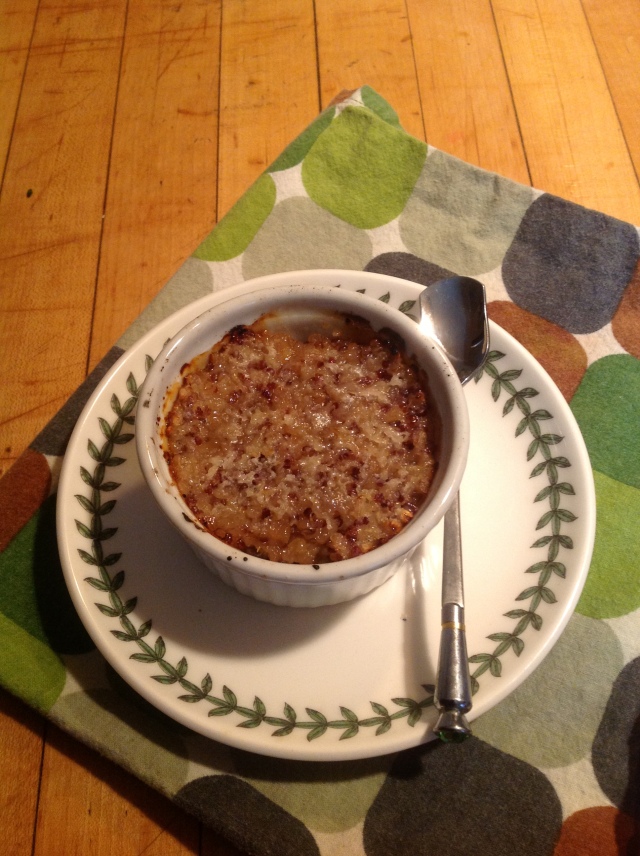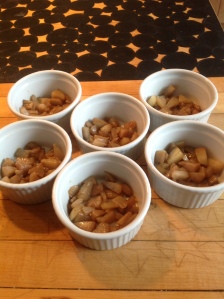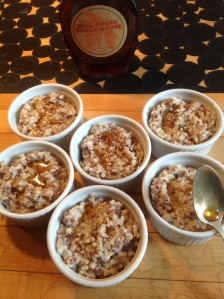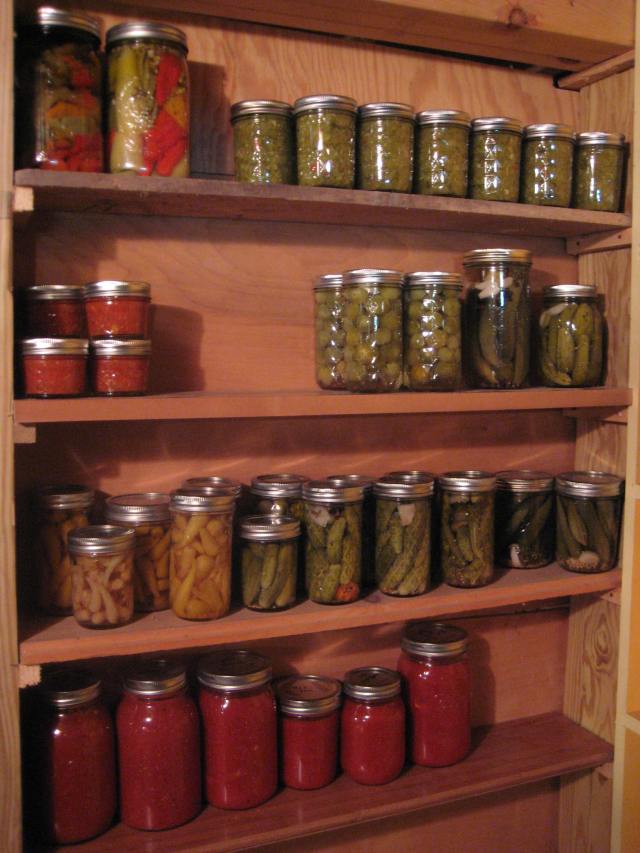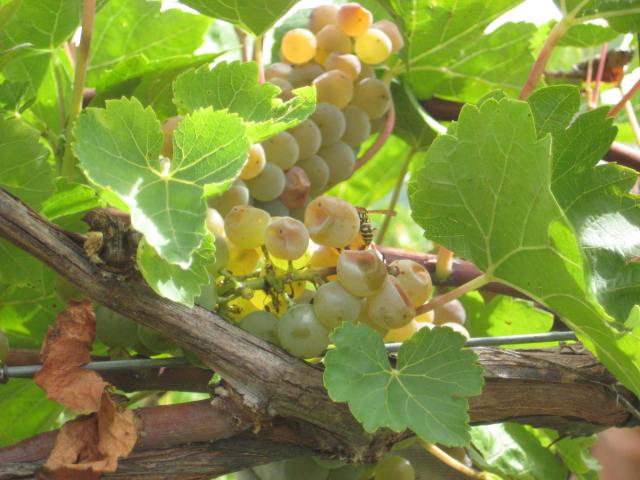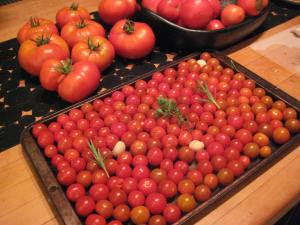
Biscotti gift bags, labeled, ribboned, ready to go
There are many affordable sweet pleasures to make at home, with a little time, a few pieces of equipment (or containers) and appealing packaging materials. As rewarding as making your own gifts is deeply gratifying, so can scaling back expectations (and budgets) in giving and receiving.
We’ve shifted our gift-giving to making a generous gift baskets for each family instead of gifts to individuals (except where children are on the list), with a focus on consumables, combining homemade with purchased locally made items.
In one weekend you can produce several items and have enough gifts for all the adults on your list. For me, working alongside a friend or family enhances the joy of the season, while speeding the process. We laugh, talk, listen to carols. We can usually complete far more items together than I would be able to do on my own.
Gift Presentation
To be ready for early or mid-December gift making you need to get your packaging materials now.
Labels that can be printed off your home printer will not hold up as well (moisture will make the ink run) nor look as good as professionally printed labels. Printed labels can be ordered online and arrive quickly. If you invest this year you’ll have plenty for years to come. Design one label to serve all purposes. Simply print your name in a homey, witty or elegant form, using an attractive font, leaving blank line/space to hand write whatever the item is (biscotti, soap, tea blends, cocktail cherries, Ginger Cider Syrup). For my first label I drew a bee logo but I didn’t plan for blank space, and because I was only thinking about my biscotti, the label isn’t as universal as it could be. For my second label I just used the name and bee in a small size, leaving room for anything I wanted to write. I chose round again so I could cover the top of the jam jars.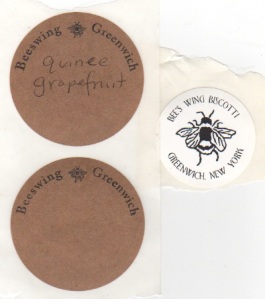
Ordering custom labels raises your efforts to a more professional look. A custom order for 500 oval labels, 2” x 1”, with your own text will cost about $50 and will last, depending on how many gifts you give, for years to come. Instead you can print your own or get a tie on tag.
Cellophane bags (available from many sources, AC Moore and Amazon among them) for baked goods and candies come in many size, flat and pleated. Make certain you buy food safe bags. I use three sizes or pleated bags: 2 x 3, 9×4 and 11×5. The largest bag holds about ¾ of a pound of biscotti, snuggly packed.
Another useful packaging material is a large roll of cellophane. This the material that gift baskets are wrapped in – you cut to size, fold and tape or staple closed. Find these at a kitchen supply store to get the best value; Amazon also carries them. 100 ft. roll costs under $25 and will last you for many years.
If like me you live miles from ready sources, where you could spend a lot of time making calls and driving around to gather all the materials you need you’ll find Amazon can save you time, energy and gas. Search under Home and Kitchen for other options and materials for packaging for sweets or candy (decorative boxes, paper candy/cookie cups).
Readily available at most supermarkets, look for unbleached waxed paper to layer between cookies or candies, or as a wrapper for baked goods or caramel. Small brown paper sandwich bags can hold a sampling of your treats or two jams jars. Adhere one of your stickers to the brown bag with a couple colorful ribbons for an elegantly simple gift-wrapping.
If you don’t grow your own or have access to wild fruit (I pick all summer and freeze until jam season), you can buy frozen fruit to make jams, fresh fruit and vegetables to make chutneys. A box of 12 -8 oz. jelly jars costs about $12. Figure in the cost of your ingredients (and your time as well) plus the jar and label cost ($2 under per item) and you have an affordable artisanal gift.
Some easy inexpensive homemade food ideas
Before the Industrial Revolution and the rise of commercial advertising people gave fewer and smaller gifts, many were homemade, and most were useful. Recipes for cider syrup and
Pickled red onions
Marinated in seasoned white vinegar thinly sliced red onions are ideal accompaniment for sandwiches, pates and chopped liver. Use a low wide-mouthed jar. For a recipe see: http://www.foodandwine.com/recipes/pickled-red-onions-rae-and-noah-bernamoff
Chutney
A simmered combination of fruit, onions, peppers and spices. A great alternative to sweet jams.
Spiced or sweet nuts

Sweet and crunchy candied walnuts
Recipes for toasting nuts abound. Check out the websites for Martha Stewart, Epicurious and 101 Cookbooks for a few ideas. Buy the nuts in bulk to save. Use one single nut in a recipe or blend them for mixed bags. Twin gift bags make a delicious treat: one bag of sweet, and one of spicy or salty, each tied with its own colored cloth ribbon.
Crackers
Crackers are easy and wildly versatile recipes let you be as creative as you want. Gluten-free and vegan, dense with herbs, seeds, nuts, or smoked salt, you can create your signature style. Pair with a wedge of local cheese and spiced nuts for a homemade gift basket.
For cocktail lovers
Make cider syrup, macerated cherries or drunken olives (recipes for the latter two will appear in an upcoming post.)
Cider Syrup Recipe
Bright and tart, spicy with ginger, cider syrup is used as a sweet flavoring in cocktails, desserts, breakfast and as an element of a savory sauce. On gallon of cider will yield about 60 ounces = 10 – 6 ounce gifts. Depending on your area cider may cost $8 to $10 a gallon.
Ingredients:
Half gallon of fresh cider
1/4 c peeled fresh ginger in slices
6 oz. jelly jars or small decorative jars with screw top or corks
Other flavor options: add one clove, one whole allspice, one stick of cinnamon
Combine cider, ginger and any flavorings in a large saucepan. You can work with larger batches in a large pot, but the reducing process will take longer. Bring to a boil over medium and cook until reduce by about half (the consistency of maple syrup is what you want for stirring into champagne, thicker is better if you want to add it to cream sauces); this will take about 2 hours on medium/low heat. The result will be rich golden brown, as pourable as maple syrup. Cider syrup an be prepared without any flavorings as well. Strain to remove any solids and follow canning procedures.
Prepare containers for canning: wash jars or bottles with hot soapy water, heat in a large stockpot with enough water to cover jars by 2 – 3”. Fill while jars are still hot. Refrigerate for several weeks.
To serve:
Add 1 – 2 t syrup per glass of prosecco, garnish with orange zest
Drizzle over ice cream, yogurt, and hot cereals
Stir a teaspoon into hot tea or mulled wine
To make a cider rosemary cream sauce: reduce 2 to 4 T syrup further, until as thick as honey. Add 1 c of heavy cream (or more to taste), one sprig of fresh rosemary, heat to thicken and serve as a sauce for chicken, squash or pasta
Some sources:
Custom printed label http://www.mavericklabel.com
Oval jars with cork closures, lidded candy dishes, hang tags, bakers twine http://www.save-on-crafts.com
Containers, candy and soap making supplies http://www.betterbee.com
 Having spent a full day indoors at the computer, the time has come to mix a cocktail (a rye Manhattan with both sweet and dry vermouth and a splash of Cocchi Vermouth di Torino) and walk in the remaining warmth of a perfect fall evening, in search of bittering agents I could dig up.
Having spent a full day indoors at the computer, the time has come to mix a cocktail (a rye Manhattan with both sweet and dry vermouth and a splash of Cocchi Vermouth di Torino) and walk in the remaining warmth of a perfect fall evening, in search of bittering agents I could dig up.
